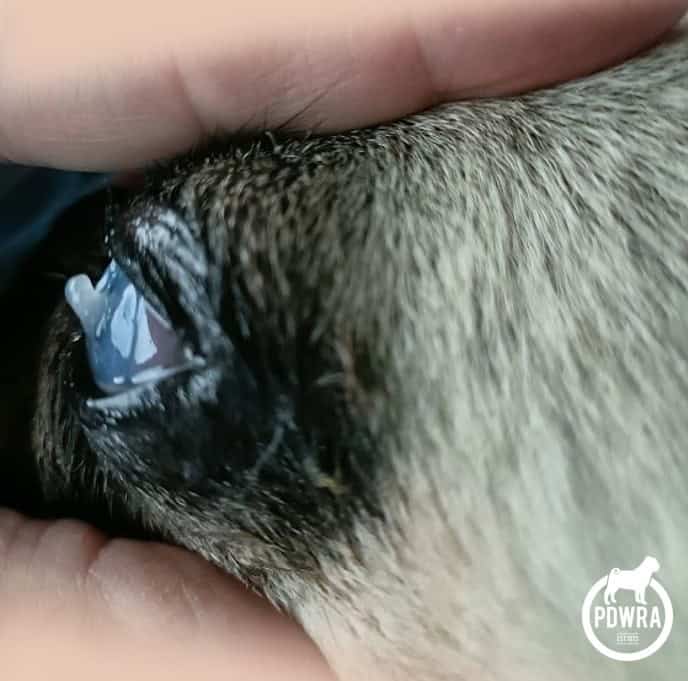Pugs have a number of significant eye conditions caused by extreme breeding creating the squashed appearance of the face. This has resulted in a shallow orbital cavity (the bony area where the eye sits), large palpebral apertures (the exposed eye) and prominent eyeballs. This together with reduction of corneal sensitivity in pugs, leads to a significant number of serious eye conditions, which are mainly due to the exposure of the eyeball and the reduced protection it has.
Because of the number and complexity of these conditions, I’m dividing the article into 2 parts (the 2nd will be in the next newsletter).
The 1st topic is as follows:-
Corneal Ulceration and Associated Conditions
Corneal ulceration (top layer of cornea is absent) can result from trauma (due to the vulnerability of a pug’s eye), hairs rubbing on cornea, or a dry cornea due to inability to close eyelids and/or lack of quantity/quality of tears. And as pugs get older, their cornea becomes more friable (and thus more prone to ulcers) so extra care and attention is needed with an aging pug’s eyes.
Unlike other dogs, when a pug has a corneal ulcer, it is potentially an eye threatening condition.
A pug’s cornea is poor at healing, so when the cornea is damaged, it is imperative to get your pug to the vet as soon as possible.
The ulcer needs to be treated intensively, and it is important your vet does this, rather than treat in a way they would a non-brachycephalic dog.
This can involve use of anti-inflammatories, along with a good quality antibiotic drops and serum or equivalent products. Drops need to be used multiple timer an day, and check ups very frequent to ensure the eye is responding to treatment.
Corneal ulceration can rapidly deteriorate to what its known as a melting ulcer without (and even with!) intensive treatment hence the frequent check ups required.
If not monitored closely, an ulcer can quickly result in a ruptured eye when surgical intervention to save the eye is too late.
If possible, as soon as a corneal ulcer is diagnosed, if you have access to an Advanced Practitioner in Ophthalmology, I would advise seeing them so the pug has the optimal treatment from the start.
A melting ulcer is where the lining of the eye (corneal stroma) starts dissolving due to bacterial and/or enzyme activity and needs intensive treatment or surgical intervention.
Non-surgical options include use of a specialised contact lens.
Sometimes the ulcer remains superficial and non-healing and the vet may suggest debridement of the edges of the ulcer to stimulate healing.
When an ulcer becomes deeper, the internal structures of the eye starts to bulge out through the cornea, which is a condition known as a descemetocele.
This is a photo of Quinn, a long term foster pug with the Charity, who recently developed the condition despite intensive treatment of the eye ulcer.

This is an ocular emergency, and will require immediate surgery if the eye is to be saved.

If the membrane breaks down, the eye will rupture (incredibly painful) and immediate surgery to remove the eye is the only option.
When an ulcer is rapidly deteriorating, surgical intervention allows the best outcome to save the sight in the eye.
If the dog has little/no sight in the affected eye, an option may also be enucleation (removal of the eye).
The most common surgery is a corneal graft, where a healthy part of the cornea is used to cover the damaged cornea. It requires a specialist to perform and is expensive, but well worth it in preserving the sight in an eye.
Another graft type uses the conjunctiva (conjunctional graft). This procedure is used when there is not enough healthy corneal tissue to use use for a graft. The conjunctiva is thicker and less translucent than corneal tissue so can reduce vision, so the preferred method is to use the cornea if at all possible.
Quinn had conjunctival graft surgery as there was too little non-damaged cornea to use for a corneal graft. His eye is recovering nicely though vision significantly reduced.
Photograph 6 weeks post op.

Following both graft surgeries, close and intensive management and monitoring is required for several weeks, to ensure the graft has been successful and the eye is healing appropriately.
Once the eye is healed the vet may recommend some ongoing maintenance treatment of the eye, for example, keeping the cornea moist by use of lubricants.
I personally think that all pugs potentially have dry corneas (and therefore an increased risk of eye ulcers), so I use a lubricant on all my pugs twice daily. A non-expensive eye lubricant that can be used as a preventative (rather than to treat a specific condition) is Carbomer which can be bought quite cheaply on Amazon.
I hope you have found this article informative, without being too technical. Part 2 of this article is available here.
The take home message is, if you notice your pug squinting, take him/her to the vet as soon as possible as it’s most likely there is a corneal ulcer, which is a potentially eye threatening condition.
Helen McKee (MRCVS)
Veterinary Advisor for the PDWRA
*******
Other PDWRA Pug Health Articles.
For more information on Pug Eye Conditions, please see: Eye Problems | The Pug Dog Welfare & Rescue Association
&
Other Pug Health Conditions, please see: Pug Health & Wellbeing | The Pug Dog Welfare & Rescue Association



